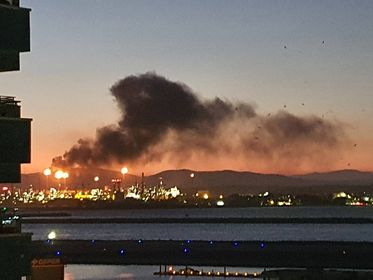http://www.esg-gib.net/wp-content/uploads/documents/Spanish-Flaring-Leaflet.pdf
SEE BELOW ENGLISH TEXT FROM LEAFLET
THE FLARES – EVERYTHING YOU SHOULD KNOW:
1. What are flares? The word “flare” is used to describe a flame that is burning off excess gas. This process usually occurs in refineries, as well as in certain chemical plants. These gases are generated when the production process is not working properly, when there is a loss of energy, or when the gases are released during maintenance periods. There are more flares in oil and gas production plants than in refineries. It also occurs in some mines, as well as many garbage dumps.
2. What is the biggest problem with flares? The flares, in short periods of time, emit large amounts of gas into the environment. They are prone to problems related to wind turbulence, and to gases not burning properly due to lack of time and temperature variations. All this contributes to the gases burning in a “dirty” way. One of the main problems with torches is that their efficiency is essentially unknown. It is often the case that refiners cite manufacturers’ specifications, as refinery operators are unaware of their own efficiency. Research carried out by the Alberta Research Council (Canada) also suggests that the number and volume of potentially toxic components escaping into the environment due to incomplete combustion are higher than previously suspected. Flaring also contributes to a number of environmental problems, such as eco-inefficiency, resource depletion, global warming, and acid deposition.
3. Why do refineries release flares or torches? These flares are intended to protect the refinery, and release the gases beyond the work areas. Therefore, its purpose is not to protect the health of those who live beyond the industrial area. Refineries use flares as a safety device with which excess gases are removed. A buildup of gases can increase pressure in the plant and cause an explosion. Some refineries flare more than they should as they use this method to dispose of waste. In the south of Durban, refineries flare up due to operational and maintenance failures, as well as for emergencies. It is interesting to know how under Engen’s new production permit, dated December 2004, refineries are not allowed to use flares for economic reasons.
4. Why do some flares emit toxic smoke? If a torch emits smoke, it is not a good torch, since what it is emitting is not being completely burned. Both Engen and Sapref in Durban gave their torches more propulsion, and this helped the flares burn properly. If a torch smokes, if the flare is very high, this practice must be denounced. Torches also smoke because the volume of gas is such that the flame cannot completely burn it.
5. Why do the flares produce such strong odors? Many gases are emitted into the environment during the entire time that the chimneys emit flares or torches. If the flare is “good”, it is only emitting carbon dioxide (CO2) and water. Since gas analysis is not done in stacks, and can only be done in laboratories, it would be a stretch to say that there are 2 gases that can make a torch smell – sulphur dioxide and hydrogen sulfide. Sulphur dioxide (SO2) is a colorless gas with a strong odor, irritates the respiratory system, and can cause or aggravate the condition of patients with asthma or bronchitis. Babies whose mothers have been subjected continuously or for long periods of time to this type of contamination during pregnancy, may be born with a predisposition to these diseases. Hydrogen Sulfide (H2S) is a highly dangerous chemical. It smells like rotten eggs. Shell’s safety committee issued an information leaflet in December 1986 explaining, “The greatest danger of hydrogen sulfide is that it can cause sudden death if inhaled in concentrated doses. Torches or flares normally emit amounts of toxic substances that are well below lethal concentrations, but are high enough to be recognized by their distinctive odor, and cause nausea and vomiting.
Another fact to take into account regarding contamination by hydrogen sulfide is that ones sense of smell becomes used to the bad smell and no longer detects it, and after a while you no longer smell it. There is then the risk that this contaminating substance can reach lethal levels and those affected do not realise it.
6. What polluting substances are issued when there are flares? According to the Public Health Association of Canada, and according to its “Position 2000” document, 250 different toxins have been identified. Among these are the following:
7. Can flares damage health? Certain polluting compounds aggravate respiratory diseases such as asthma. The “EPA Enforcement Alert October 2000” of the United States says the following:
Hydrogen Sulfide is considered a cyanide-like toxin. Flaring torches can produce high concentrations of sulphur dioxide in the environment. Those people who could be exposed even for short periods of time to high levels of sulphur dioxide may suffer lung damage that would be accompanied by discomfort such as shortness of breath due to congestion of the respiratory tract.
8. Can the torches or flares affect air quality? Flares can affect air quality, particularly if they are not burning well. Stations for observing air quality have detected an increase in solid particles during those periods in which the chimneys have been emitting torches or flames. It is also known to increase hydrogen sulfide concentrations at ground level. Flares also cause carbon dioxide levels to rise. Incomplete combustion emits solid particles (soot) and hydrocarbons into the atmosphere that are harmful to health. Studies conducted in Houston, Texas, reveal that smog levels can increase as a result of increased flares, which in turn increase VOC and sulphur dioxide emissions.
Solid particles (soot) Benzene Benzoprine Carbon di-sulphide (CS) Carbonyl Sulphide (Cos) toluene
Mercury And many more.
INFORMATION: THE BAY BUCKET BRIGADE IN COLABORATION WITH “LA PLATAFORMA POR EL ESTUDIO EPIDEMIOLOGICO YA!”
JUNE 2006





